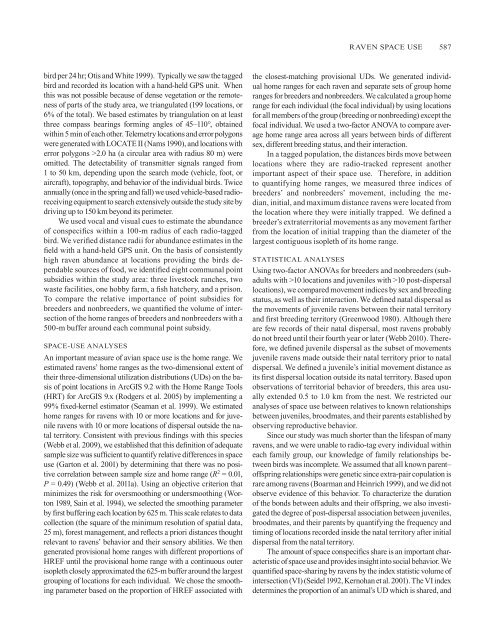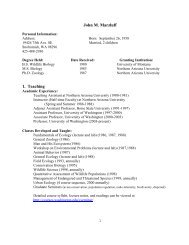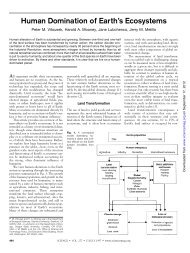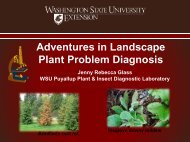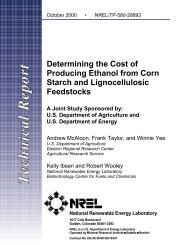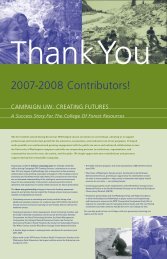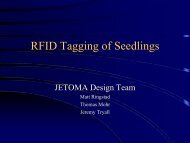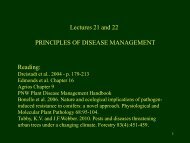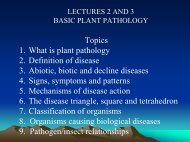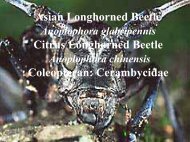DIFFERENCES IN SPACE USE by COMMON RAVENS IN ...
DIFFERENCES IN SPACE USE by COMMON RAVENS IN ...
DIFFERENCES IN SPACE USE by COMMON RAVENS IN ...
- No tags were found...
Create successful ePaper yourself
Turn your PDF publications into a flip-book with our unique Google optimized e-Paper software.
Raven Space Use 587bird per 24 hr; Otis and White 1999). Typically we saw the taggedbird and recorded its location with a hand-held GPS unit. Whenthis was not possible because of dense vegetation or the remotenessof parts of the study area, we triangulated (199 locations, or6% of the total). We based estimates <strong>by</strong> triangulation on at leastthree compass bearings forming angles of 45–110°, obtainedwithin 5 min of each other. Telemetry locations and error polygonswere generated with LOCATE II (Nams 1990), and locations witherror polygons >2.0 ha (a circular area with radius 80 m) wereomitted. The detectability of transmitter signals ranged from1 to 50 km, depending upon the search mode (vehicle, foot, oraircraft), topography, and behavior of the individual birds. Twiceannually (once in the spring and fall) we used vehicle-based radioreceivingequipment to search extensively outside the study site <strong>by</strong>driving up to 150 km beyond its perimeter.We used vocal and visual cues to estimate the abundanceof conspecifics within a 100-m radius of each radio-taggedbird. We verified distance radii for abundance estimates in thefield with a hand-held GPS unit. On the basis of consistentlyhigh raven abundance at locations providing the birds dependablesources of food, we identified eight communal pointsubsidies within the study area: three livestock ranches, twowaste facilities, one hob<strong>by</strong> farm, a fish hatchery, and a prison.To compare the relative importance of point subsidies forbreeders and nonbreeders, we quantified the volume of intersectionof the home ranges of breeders and nonbreeders with a500-m buffer around each communal point subsidy.Space-use analysesAn important measure of avian space use is the home range. Weestimated ravens’ home ranges as the two-dimensional extent oftheir three-dimensional utilization distributions (UDs) on the basisof point locations in ArcGIS 9.2 with the Home Range Tools(HRT) for ArcGIS 9.x (Rodgers et al. 2005) <strong>by</strong> implementing a99% fixed-kernel estimator (Seaman et al. 1999). We estimatedhome ranges for ravens with 10 or more locations and for juvenileravens with 10 or more locations of dispersal outside the natalterritory. Consistent with previous findings with this species(Webb et al. 2009), we established that this definition of adequatesample size was sufficient to quantify relative differences in spaceuse (Garton et al. 2001) <strong>by</strong> determining that there was no positivecorrelation between sample size and home range (R 2 = 0.01,P = 0.49) (Webb et al. 2011a). Using an objective criterion thatminimizes the risk for oversmoothing or undersmoothing (Worton1989, Sain et al. 1994), we selected the smoothing parameter<strong>by</strong> first buffering each location <strong>by</strong> 625 m. This scale relates to datacollection (the square of the minimum resolution of spatial data,25 m), forest management, and reflects a priori distances thoughtrelevant to ravens’ behavior and their sensory abilities. We thengenerated provisional home ranges with different proportions ofHREF until the provisional home range with a continuous outerisopleth closely approximated the 625-m buffer around the largestgrouping of locations for each individual. We chose the smoothingparameter based on the proportion of href associated withthe closest-matching provisional UDs. We generated individualhome ranges for each raven and separate sets of group homeranges for breeders and nonbreeders. We calculated a group homerange for each individual (the focal individual) <strong>by</strong> using locationsfor all members of the group (breeding or nonbreeding) except thefocal individual. We used a two-factor ANOVA to compare averagehome range area across all years between birds of differentsex, different breeding status, and their interaction.In a tagged population, the distances birds move betweenlocations where they are radio-tracked represent anotherimportant aspect of their space use. Therefore, in additionto quantifying home ranges, we measured three indices ofbreeders’ and nonbreeders’ movement, including the median,initial, and maximum distance ravens were located fromthe location where they were initially trapped. We defined abreeder’s extraterritorial movements as any movement fartherfrom the location of initial trapping than the diameter of thelargest contiguous isopleth of its home range.Statistical analysesUsing two-factor ANOVAs for breeders and nonbreeders (subadultswith >10 locations and juveniles with >10 post-dispersallocations), we compared movement indices <strong>by</strong> sex and breedingstatus, as well as their interaction. We defined natal dispersal asthe movements of juvenile ravens between their natal territoryand first breeding territory (Greenwood 1980). Although thereare few records of their natal dispersal, most ravens probablydo not breed until their fourth year or later (Webb 2010). Therefore,we defined juvenile dispersal as the subset of movementsjuvenile ravens made outside their natal territory prior to nataldispersal. We defined a juvenile’s initial movement distance asits first dispersal location outside its natal territory. Based uponobservations of territorial behavior of breeders, this area usuallyextended 0.5 to 1.0 km from the nest. We restricted ouranalyses of space use between relatives to known relationshipsbetween juveniles, broodmates, and their parents established <strong>by</strong>observing reproductive behavior.Since our study was much shorter than the lifespan of manyravens, and we were unable to radio-tag every individual withineach family group, our knowledge of family relationships betweenbirds was incomplete. We assumed that all known parent–offspring relationships were genetic since extra-pair copulation israre among ravens (Boarman and Heinrich 1999), and we did notobserve evidence of this behavior. To characterize the durationof the bonds between adults and their offspring, we also investigatedthe degree of post-dispersal association between juveniles,broodmates, and their parents <strong>by</strong> quantifying the frequency andtiming of locations recorded inside the natal territory after initialdispersal from the natal territory.The amount of space conspecifics share is an important characteristicof space use and provides insight into social behavior. Wequantified space-sharing <strong>by</strong> ravens <strong>by</strong> the index statistic volume ofintersection (VI) (Seidel 1992, Kernohan et al. 2001). The VI indexdetermines the proportion of an animal’s UD which is shared, and


